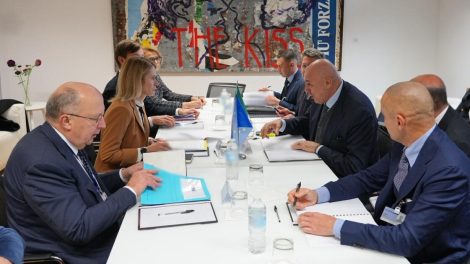The biggest Italian and Spanish shipbuilders, Fincantieri and Navantia, have signed a Memorandum of Understanding to strengthen their already close relationship and explore the shared benefit of a broadened collaboration in the naval and maritime domains.
The signature took place in the Navantia stand at the FEINDEF exhibition in Madrid and was brought forward by General Manager Naval Vessels Division of Fincantieri Giuseppe Giordo and Navantia Chairman Ricardo Domínguez.
In a joint release, the companies stated they aim to assess future opportunities for the Italian and Spanish Navies, which aside from joint projects include the development of future destroyers and other naval platforms built for the future European Defence Force.
“We are very satisfied to give substance to a plan that can no longer be postponed and to build a collaboration path based on important programs of the two Navies,” commented Giuseppe Bono, managing director of Fincantieri.
“We aim to strengthen European Defence and boost [this industry’s global] position,” stated Mr Domínguez, “and we think that agreements as ours pave the way towards this objective.” Mr Bono added that both companies have “long agreed that, in order to stand its ground with the global challenges of the future, we need a robust and long-lasting cooperation in the defence and security field at a European level.”
The EPC programme and Italy’s plans for the Navy
Both shipyards already collaborate – together with the French Naval Group and the Naviris joint venture – within the framework of the European Patrol Corvette (EPC) programme, the most important naval initiative in the EU’s Permanent Structured Cooperation (PESCO) project.
At the beginning of October, the Italian Navy chaired the operational meeting that featured the representatives of the other involved countries (namely France, Spain, Greece and Portugal) and industries, as well as the European Defense Agency (EDA), which has been identified as the institutional framework for the definition and harmonisation of common requirements.
Italy’s Defence Minister Lorenzo Guerini himself called the EPC “the program with the greatest potential, from a naval viewpoint,” as he presented his 2021-2023 plan to the Italian Parliament’s Defence Committees.
The plan entails the acquisition of new destroyers (DDX) in the financial coverage, which forecasts almost €1.9 billion up to 2035 to equip the Navy with two replacement units. An additional €400 million up to 2035 have been earmarked for acquiring two offshore units (LLS) to replace the more obsolete logistics units.
A total of €3 million will cover the first phase of the study of the “new amphibious units” programme. €170 million are expected to be spent on the half-life modernisation of the Doria class destroyers up to 2027.
The sea’s newfound centrality
The baseline is the awareness of the wider Mediterranean’s renewed centrality. The area, along with the sea dimension in more general terms, is of utmost interest for the security and defence of the country.
Admiral Enrico Credendino explained this much last week, onboard the Cavour aircraft carrier, on his first public appearance after being designated by the Council of Ministers as the next Chief of Staff of the Navy.
“We want to work together with the community to remind everyone that Italy is a maritime country, whose safety and well-being are closely linked to the sea,” he said. On Thursday he will officially replace Admiral Giuseppe Cavo Dragone, who has already been appointed the next Chief of Defense Staff.





